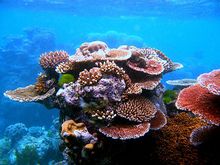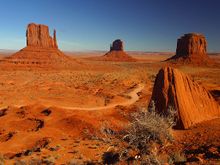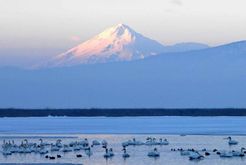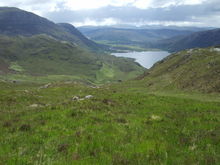A Biome Will Contain Multiple
Biome
Biomes are nature's major ecological communities, classified according to the predominant vegetation, climate, and characterized past adaptations of organisms to that particular surround.[one] Biomes are often defined past abiotic (non-living) factors such equally climate, topographic relief (the shape of the landscape), geology, soils, and vegetation. Biomes may comprise multiple ecosystems.[ii]
Biomes are extremely of import and have changed many times throughout World's history. Anthropogenic (human) activities have recently been affecting biomes,[3] which is a concern peculiarly equally free energy apply and greenhouse gas emissions continue to increase. Since these regions depend on a stable climate, climatic change results in altered conditions within a biome.
There accept been various biome classification systems devised over the years. The two most normally used systems are the Walter nomenclature scheme and the Whittaker classification scheme. The Walter organisation is based on the annual cycles of precipitation and temperature, along with the resulting vegetation that grows due to these conditions. The Whittaker scheme is based primarily on vegetation and is modified based on climate conditions.[4] The common footing betwixt these two popular classification schemes are the v major biomes presented below.
The Koppen-Geiger climate classification is a more complex classification system that is increasingly being used for dealing with climate change bug. This classification systems is very detailed, with multiple subcategories. This allows for much more fine-tuned classification, making it easier to show how the climate is shifting in a identify over time. [5]
- Major Biomes
-

-

-

-

-

Types
In that location are 5 major types of biomes:[3]
Aquatic
Water is abundant all over the Earth, making up about 75% of the full biosphere.[3] Life began in water billions of years ago, when the commencement molecules important for life came together. There are numerous species of plants and animals in aquatic environments, ranging from the deep ocean to shallow ponds. Aquatic biomes can be split into two categories - marine (oceans, coral reefs) and freshwater (ponds, rivers).
Desert
Deserts are extremely dry out; they become less than 50 cm of pelting per yr.[iii] They cover about a 5th of the Earth's surface, and are typically establish in mid-latitudes (around 30°N or S) due to the Earth's prevailing winds.[11] Only specialized plants and animals are capable of living in these regions due to the lack of water they receive. It is rare for large animals to thrive here due to intense temperatures and lack of shade from the Sun.
Tundra
Tundras are the coldest of the biomes. They ususally occur at high latitudes (higher up 60°N or S). They are characterized by low temperatures, frost molded landscapes, niggling precipitation, lack of nutrients, and brusque growing seasons.[12] These characteristics lead to a full general lack of biodiversity since only extremely well-adapted species of animals and plants tin live here.
Wood
Forests are ane of the more diverse biomes, with plenty of history and sociology centered around them. Forests cover a tertiary of the Earth'south land and comprise over lxx% of the carbon present in living things.[3] The resources present in forests are valuable to humans, whether it be the wood itself for use as a fuel and other industry purposes, or the desire for the land occupied by the woods. This has lead to mass deforestation and pollution in once-thriving ecosystems.
Grassland
Grasslands are lands dominated by grass rather than trees or shrubs. At that place are ii main types, the savanna (tropical) and temperate grasslands.[3]
Savannas cover almost half the surface of Africa and portions of Australia, South America, and India. They are characterized by hot climates with consequent rainfall for 6-8 months, followed by months filled with drought.
Temperate grasslands have almost no trees, and have less rainfall than savannas. Temperatures vary more from summer to wintertime likewise, with very hot summers and very cold winters. Temperate grasslands tin exist constitute in the prairies of North America, the pampas of South America, and the steppes of the erstwhile Soviet Union.
For Further Reading
- Precipitation
- Climate
- Ecosystem
- Biosphere
- Water
- Or explore a random folio
UC Berkeley has biome pages with additional information on these topics:
- Grassland
- Aquatic
- Desert
- Wood
- Tundra
References
- ↑ Campbell, N.A. 1996. Biology, quaternary Edition. The Benjamin/Cummings Publishing Company, Inc., Menlo Park, California. via UC Berkeley, The World's Biomes [Online], Available: http://world wide web.ucmp.berkeley.edu/glossary/gloss5/biome/
- ↑ eSchoolToday. (Accessed September i, 2015). What is a biome? [Online], Available: http://eschooltoday.com/ecosystems/what-is-a-biome.html
- ↑ 3.0 3.1 3.ii three.3 3.four 3.5 UC Berkeley. (Accessed Sept. 1, 2015). The World'southward Biomes [Online], Available: http://www.ucmp.berkeley.edu/glossary/gloss5/biome/
- ↑ Ricklefs, R. E. "The economy of nature: a textbook in basic ecology." (1993). Affiliate v [Online], Available: http://www.ecologia.polimi.information technology/wp-content/uploads/2016/03/chap5_ricklefs_biomes.pdf
- ↑ NOAA. "Koppen-Geiger Climate Changes - 1901 - 2100" (2007). [Online], Available: https://sos.noaa.gov/datasets/koppen-geiger-climate-changes-1901-2100/
- ↑ Wikimedia Commons [Online], Available: https://en.wikipedia.org/wiki/Great_Barrier_Reef#/media/File:Coral_Outcrop_Flynn_Reef.jpg
- ↑ Public Domain Images [Online], Available: http://www.public-domain-image.com/nature-landscape/desert/slides/monument-valley-towers.html
- ↑ Public Domain Images [Online], Available: http://www.public-domain-epitome.com/free-images/fauna-animals/birds/swans-pictures/tundra-swan/tundra-swans-in-a-lake-with-mt-shasta-in-the-background
- ↑ Wikimedia Commons [Online], Available: https://en.wikipedia.org/wiki/Northeastern_coastal_forests#/media/File:Posts_Brook_from_Norvin_Green_State_Forest_Lower_Trail.jpg
- ↑ Geograph (Accessed Sept. ane, 2015) [Online], Available: http://www.geograph.org.uk/photograph/1360416
- ↑ G. Boyle. Renewable Energy: Ability for a Sustainable Future, 2nd ed. Oxford, UK: Oxford University Press, 2004.
- ↑ UC Berkeley. (Accessed Sept i, 2015). The Tundra Biome [Online], Available: http://www.ucmp.berkeley.edu/glossary/gloss5/biome/tundra.html
A Biome Will Contain Multiple,
Source: https://energyeducation.ca/encyclopedia/Biome
Posted by: bellprelf1959.blogspot.com


0 Response to "A Biome Will Contain Multiple"
Post a Comment